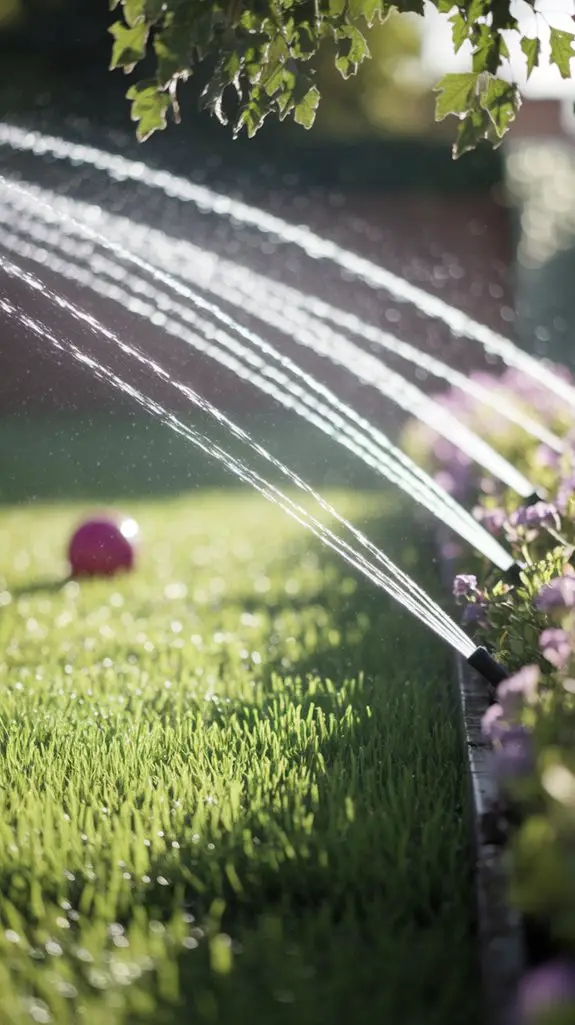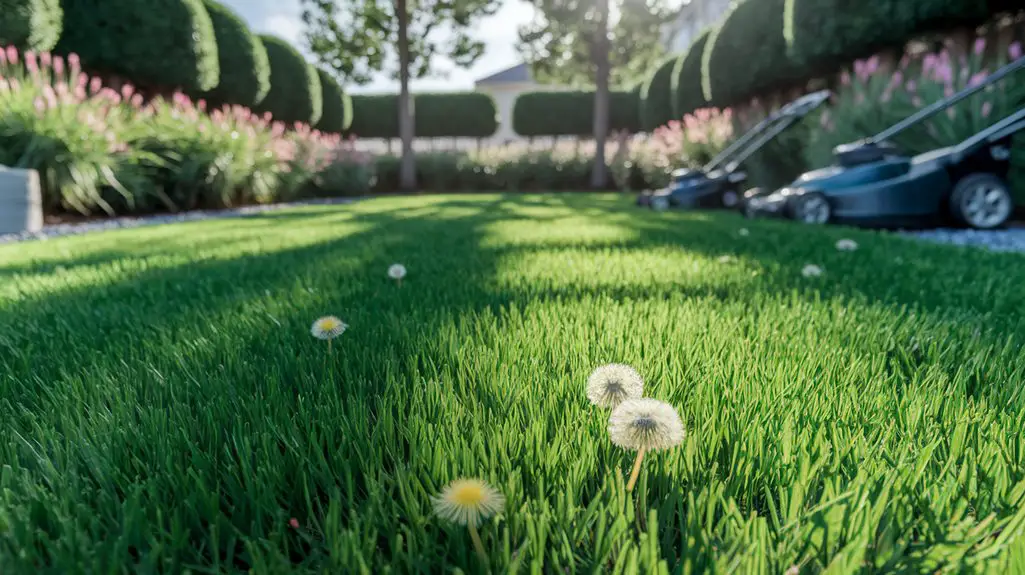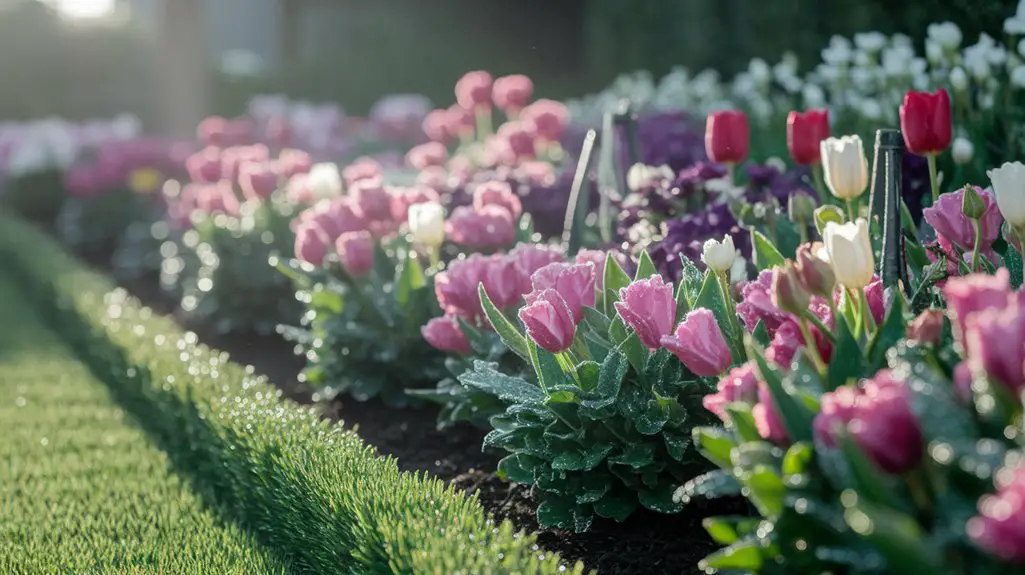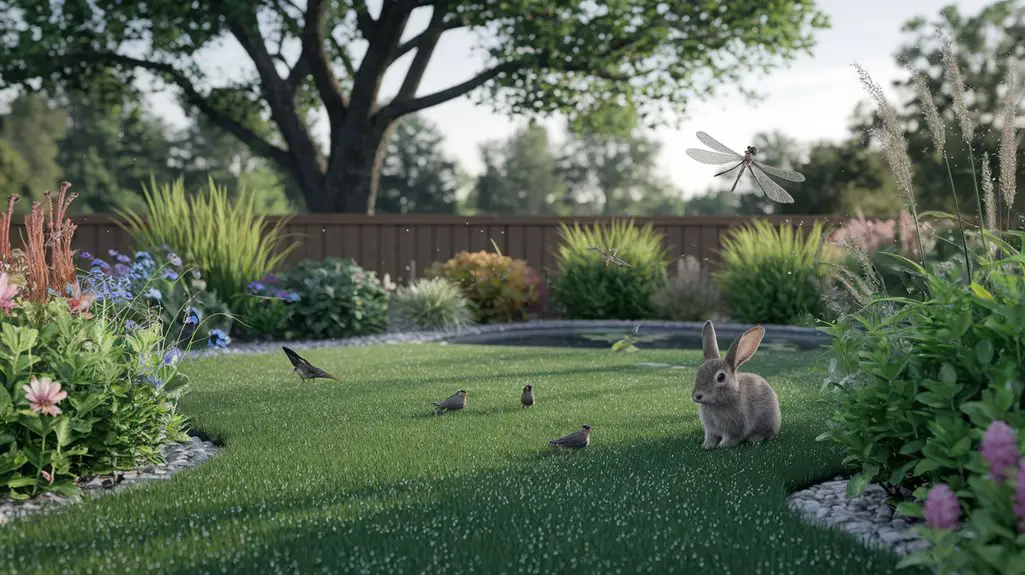Your backyard isn’t just grass—it’s the foundation for family memories, neighborhood gatherings, and personal relaxation. You’ll need strategic lawn care to transform this space into the ideal recreational zone. Proper mowing heights protect roots while promoting dense growth, and targeted watering schedules create resilient turf that withstands foot traffic. These seven maintenance techniques balance aesthetics with functionality, ensuring your outdoor space remains both beautiful and practical throughout every backyard adventure.
Achieving the Perfect Grass Height for Outdoor Activities
When establishing ideal grass height for recreational use, you’ll need to balance functionality with turf health.
Maintain cool-season grasses at 2.5-3.5 inches, which promotes deeper root systems and drought resistance while providing adequate cushioning for activities.
For high-traffic play areas, implement a 48-hour mowing schedule before events—cutting to the upper maintenance threshold enhances turf resilience.
Never remove more than one-third of blade length during a single cut to prevent stress responses.
Utilize a reel mower for precision cuts that heal faster than rotary blade injuries.
During peak summer temperatures, raise cutting height by ½ inch to mitigate heat stress.
For sports requiring ball roll, such as croquet or bocce, maintain a lower 1.5-inch threshold, but increase irrigation frequency accordingly. Additionally, regular lawn care practices can significantly improve the overall health and appearance of your grass.
Effective Watering Strategies for a Resilient Play Surface

How effectively you irrigate your lawn directly impacts its performance as a play surface. Apply water deeply but infrequently—1-1.5 inches per session—to encourage deep root development. Roots that extend 4-6 inches below the surface create turf that’s more resistant to foot traffic damage.
Water during pre-dawn hours (4-6 AM) when evaporation rates are minimal and wind speeds are low, maximizing absorption efficiency. Install moisture sensors or smart controllers to prevent overwatering, which leads to shallow roots and thatch buildup.
For high-traffic areas, implement a supplemental watering protocol: apply an additional 0.5 inches 24 hours before intensive use. This hydration buffer enhances cellular turgidity, allowing grass blades to withstand compression while reducing divot formation and recovery time. Additionally, incorporating organic lawn care practices can further improve the resilience and health of your lawn.
Natural Weed Control for Barefoot-Friendly Lawns

Maintaining a weed-free lawn without harsh chemicals requires strategic cultural practices that complement your turf’s natural competitive advantages.
Mow high (3-4 inches) to shade weed seedlings and strengthen grass root systems. Apply corn gluten meal in early spring as a pre-emergent barrier that inhibits seed germination while fertilizing your lawn.
For existing weeds, implement targeted extraction with specialized tools that remove the entire root system. A 5% acetic acid solution works effectively on young broadleaf weeds.
Overseed thin areas immediately after weed removal to prevent reinfestation.
Enhance soil biology by applying compost tea monthly during growing seasons. This microbial boost helps your turf outcompete unwanted vegetation while breaking down thatch. Additionally, incorporating effective pest control techniques can help protect your lawn from insect damage that may weaken grass health.
Creating Designated Play Zones to Preserve Your Green Space
While balancing family enjoyment with lawn preservation may seem challenging, strategic play zone design offers an ideal solution for high-traffic residential landscapes.
Designate 30-40% of your yard for recreational use with resilient materials like artificial turf, rubber mulch, or engineered wood fiber that withstand intensive activity.
Install permeable pavers for boundary areas, creating clear distinctions between play zones and maintained turf. You’ll reduce soil compaction on primary lawn sections while accommodating high-impact activities in reinforced zones.
For sports areas, utilize drought-resistant turfgrass varieties like Bermuda or tall fescue that recover rapidly from foot traffic.
Implement rotation schedules for play activities to prevent excessive wear patterns. This systematic approach optimizes both recreational functionality and aesthetic lawn quality without compromising either objective. Additionally, proper lawn maintenance ensures that your green space remains healthy and vibrant in the long run.
Soil Aeration Techniques for a Springy, Safe Play Area
Proper soil aeration represents the cornerstone of developing resilient play areas that absorb impact effectively while maintaining ideal drainage capacity.
Core aeration with a mechanical aerator provides excellent results—extract 2-3 inch soil plugs at 3-inch intervals during spring or fall when soil moisture content is moderate.
For compacted play zones, employ deep-tine aeration to penetrate 6-8 inches, disrupting subsurface compaction layers.
Follow aeration with topdressing using a 70/30 sand-compost mixture at ¼-inch depth to fill cores and enhance microbial activity.
You’ll need to aerate high-traffic areas twice annually, while peripheral zones require only once-yearly treatment.
Monitor soil compaction using a penetrometer; readings exceeding 300 psi indicate immediate aeration necessity.
This maintenance schedule guarantees excellent turf resilience and safety for active play. Additionally, incorporating low-maintenance yards into your landscape design can further reduce upkeep while ensuring a fun environment for outdoor activities.
Seasonal Fertilization to Support High-Traffic Entertainment Areas
Just as aerated soil permits oxygen circulation, your entertainment spaces require precise nutrient delivery to withstand foot traffic.
Apply nitrogen-rich slow-release fertilizer (20-5-10) in early spring to stimulate robust root development before summer gatherings. For mid-season recovery, utilize a balanced 10-10-10 formula supplemented with iron to accelerate repair of worn patches.
In autumn, switch to potassium-heavy blends (8-8-24) that enhance cell wall strength and cold tolerance.
Calculate application rates at 1 pound of nitrogen per 1,000 square feet for ideal coverage. For barbecue or game areas, increase application frequency by 25% but reduce concentration to prevent burn.
Pre-treat event spaces 14 days before major gatherings to maximize tensile strength. Incorporating eco-friendly lawn care practices can further promote sustainability in your yard.
Always water thoroughly post-application to activate compounds and prevent nitrogen volatilization.
Eco-Friendly Pest Management for Family-Friendly Yards
Maintaining a pest-free lawn without compromising family safety requires strategic biological controls and targeted organic solutions.
Implement integrated pest management (IPM) protocols to minimize chemical interventions while maximizing efficacy against common lawn invaders.
- Deploy beneficial nematodes to target grubs and soil-dwelling pests—these microscopic organisms eliminate destructive larvae without residual toxicity.
- Introduce predatory insects such as ladybugs and lacewings to naturally control aphid populations and reduce plant damage.
- Apply corn gluten meal as a pre-emergent herbicide that suppresses weed germination while supplementing nitrogen levels.
For persistent infestations, utilize botanical insecticides containing pyrethrins or neem oil extracts.
These compounds break down rapidly, leaving no harmful residue where children and pets play, while effectively disrupting pest reproduction cycles. Additionally, incorporating natural insecticides can further enhance your garden’s defenses against unwanted pests.
Conclusion
You’ve now equipped yourself with the essential lawn care techniques for a high-performance backyard ecosystem. Implement these strategies consistently, and you’ll see measurable improvements within 4-6 weeks. Studies show that properly maintained lawns absorb approximately 300 gallons of water per 1,000 square feet during rainfall events—significantly reducing runoff and erosion while enhancing your outdoor recreational capacity. Prioritize these maintenance protocols for peak functionality and environmental sustainability.



